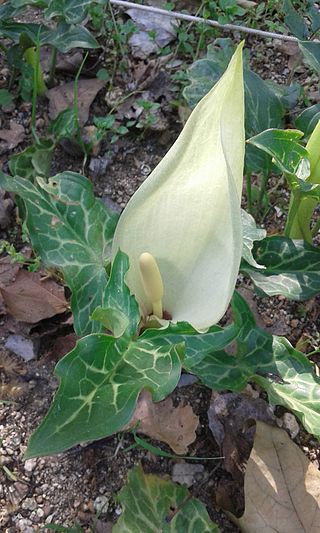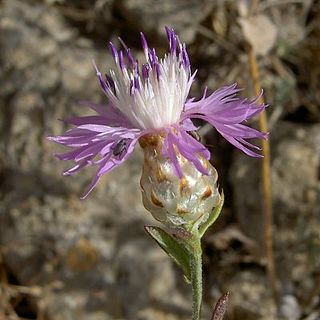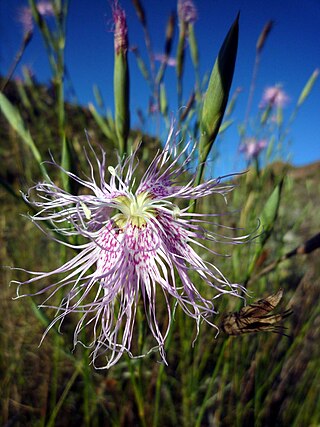
Cistus ladanifer is a species of flowering plant in the family Cistaceae. It is native to the western Mediterranean region. Common names include gum rockrose, labdanum, common gum cistus, and brown-eyed rockrose.

Coriaria is the sole genus in the family Coriariaceae, which was described by Linnaeus in 1753. It includes 14 species of small trees, shrubs and subshrubs, with a widespread but disjunct distribution across warm temperate regions of the world, occurring as far apart as the Mediterranean region, southern and eastern Asia, New Zealand, the Pacific Ocean islands, and Central and South America.

Pickeringia is a monotypic genus of flowering plants in the legume family, Fabaceae. It was recently assigned to the unranked, monophyletic Cladrastis clade. It was named after the naturalist Charles Pickering. Its only species is Pickeringia montana, which is known by the common name chaparral pea. It is native to California, where its distribution extends along the Coast Ranges and the Sierra Nevada foothills, as well as the Peninsular Ranges of Southern California and northern Baja California. It is also known from Santa Cruz Island.

Baldellia is a genus of aquatic plants commonly known as lesser water-plantains. It includes three species found across much of Europe and the Mediterranean from Ireland and the Canary Islands to Turkey and Estonia. The genus is named in honor of the Italian nobleman Bartolommeo Bartolini-Baldelli. Baldellia is very closely related to Echinodorus.

Arum italicum is a species of flowering herbaceous perennial plant in the family Araceae, also known as Italian arum and Italian lords-and-ladies. It is native to the British Isles and much of the Mediterranean region, the Caucasus, Canary Islands, Madeira and northern Africa. It is also naturalized in Belgium, the Netherlands, Austria, Argentina, North Island New Zealand and scattered locations in North America.

Baphia is a small genus of legumes that bear simple leaves. Baphia is from the Greek word βάπτω, referring to a red dye that is extracted from the heartwood of tropical species. The genus is restricted to the African tropics. Baphia was traditionally assigned to the tribe Sophoreae; however, recent molecular phylogenetic analyses reassigned Baphia to the tribe Baphieae.

Galegeae is a tribe in the flowering plant family Fabaceae, subfamily Faboideae. The tribe is found mostly in the northern hemisphere, but can also be found in Australia, Africa, and South America. Recent molecular phylogenetic work has determined that tribe Galegeae is paraphyletic, and that its members are scattered throughout the IR-lacking clade.

Adenocarpus is a genus of flowering plants in the family Fabaceae. It belongs to the subfamily Faboideae. The plants are broom-like shrubs with bright yellow flowers. The genus is native to the Mediterranean Basin and sub-Saharan Africa, but finds its highest diversity in Northwest Africa and the Iberian Peninsula.

Hypocalyptus is a genus of flowering plants in the family Fabaceae. It includes three species of shrubs, subshrubs or small trees native to the Cape region of South Africa. Typical habitats include Mediterranean-climate shrubland (fynbos) at forest margins, in rocky and sandy areas, and along streams, often at high elevations.
Petaladenium urceoliferum is a species of flowering plant in the family Fabaceae. It is a tree native to northern Brazil. It grows in tropical lowland Amazon rainforest in the basin of the Rio Negro, a northern tributary of the Amazon. It is the only member of the genus Petaladenium. The genus belongs to tribe Amburaneae in subfamily Faboideae.

Boguslav Stanislavovich Kurlovich is a Russian-Finnish scientific agronomist of Polish descent. He specializes in the field of plant genetic resources, botany, plant and fish breeding.

Cytinus hypocistis is an ant-pollinated species of parasitic plant in the family Cytinaceae having four subspecies. It is found primarily in locations that surround the Mediterranean Sea, and is the type for the genus Cytinus. The binomial has been conserved.

The Genistoids are one of the major radiations in the plant family Fabaceae. Members of this phylogenetic clade are primarily found in the Southern hemisphere. Some genera are pollinated by birds. The genistoid clade is consistently resolved as monophyletic in molecular phylogenetic analyses. It is estimated to have arisen 56.4 ± 0.2 million years ago. A node-based definition for the genistoids is: "the MRCA of Poecilanthe parviflora and Lupinus argenteus." One morphological synapomorphy has been tentatively identified: production of quinolizidine alkaloids. Some genera also accumulate pyrrolizidine. A new genus, to be segregated from Clathrotropis, has also been proposed to occupy an undetermined position within the genistoid clade.

Centaurea alba is a species of Centaurea found in the Iberian Peninsula in southern and central Spain and in a small neighbouring area in the interior of Portugal. There are three recognised subspecies, and of one subspecies, the nominate, there are furthermore three varieties.

Microcnemum is a genus in the plant family Amaranthaceae, containing a single species, Microcnemum coralloides. It is a dwarf annual halophyte with fleshy, apparently jointed stems and reduced leaves and flowers. The two subspecies show a disjunct distribution in Spain and Western Asia.
Meso-Papilionoideae is a monophyletic clade of the flowering plant subfamily Faboideae that includes the majority of papilionoid legumes. This clade is consistently resolved in molecular phylogenies. It contains many agronomically important genera, including Arachis (peanut), Cicer (chickpea), Glycine (soybean), Medicago (alfalfa), Phaseolus, Trifolium (clover), Vicia (vetch), and Vigna.

Dianthus broteri is a species of flowering plant in the carnation family Caryophyllaceae. It is native to Portugal and Spain, preferring to grow close to the coasts. Dianthus broteri is a complex of polyploid races, with 2n=2x=30, 2n=4x=60, 2n=6x=90 and 2n=12x=180 chromosomes detected in different populations, the largest polyploid series in the genus.
Andromonoecy is a breeding system of plant species in which male and hermaphrodite flowers are on the same plant. It is a monomorphic sexual system comparable with monoecy, gynomonoecy and trimonoecy. Andromonoecy is frequent among genera with zygomorphic flowers, however it is overall rare and occurs in less than 2% of plant species. Nonetheless the breeding system has gained interest among biologists in the study of sex expression.

A sexual system is a distribution of male and female functions across organisms in a species. The terms reproductive system and mating system have also been used as synonyms.

Silene italica is a species of plant native to Southern Europe and parts of Asia. It is also introduced to parts of the United States and Northern Europe.



















